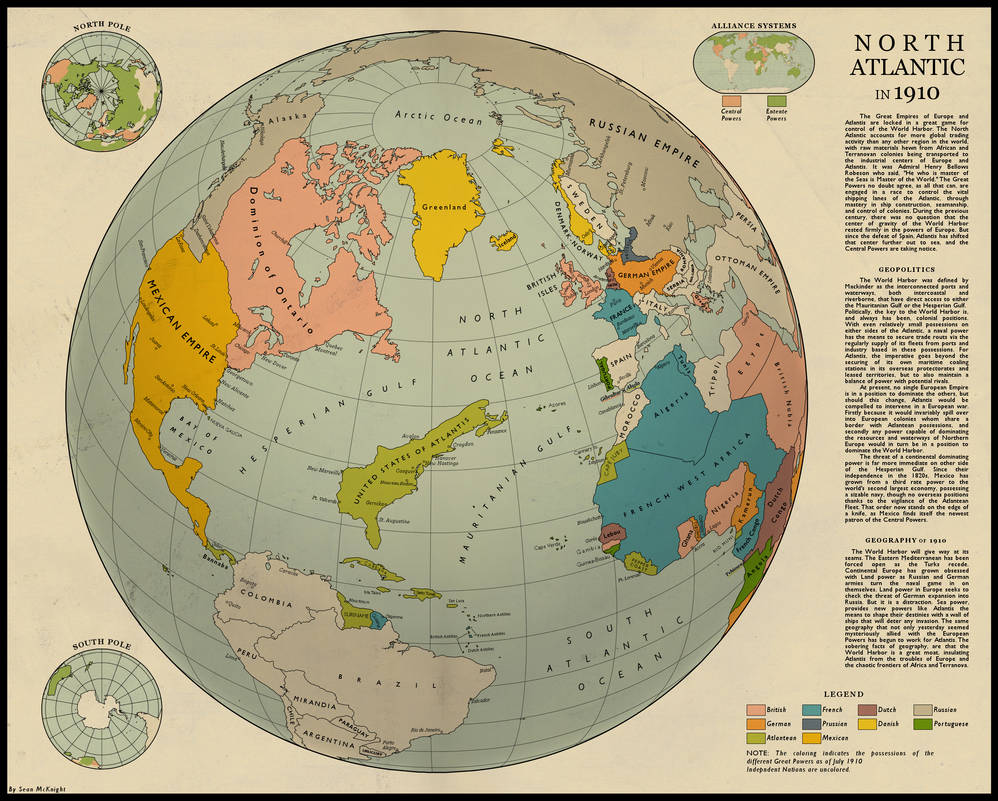This map is base upon the Atlantist series by harry turtledove.
The map is self is base on this map


I'm surprised not to see more gray in France. Does Aachen not count as a Carolingian capital?
EDIT: Also, Arica should be colored Peruvian.
Ethiopia was under the rule of Italy from 1936 to 1941.View attachment 547828
Most Recent Foreign Sovereignty
Full Sovereignty does not necessarily include all forms of political/military control
Foreign being the colour of the modern country where the previous country had their latest capital at the time it held the territory.
Sometimes, the previous owner's capital is still in the modern country, therefore is not "foreign", so the next most foreign is shown.
Example: Independent Texas in Mexico instead of having the USA color, because although the Texan capital being inside the modern USA would warrant the USA colour, it would be the same as the current USA, so it gets excluded.
Edit: Also, the light grey is for regions that have apparently never had a previous foreign rulership. This includes perpetually self-governing places such as Japan, or recently colonized places such as Pacific Islands.
Anyway this wraps up my latest "recent sovereignty" series with some nice eye cancer
*whispers*Ethiopia was under the rule of Italy from 1936 to 1941.
No they actually took control of the country and incorporated it into Italian East Africa along with Eritrea and Somalia. It was treated like a colonial territory.*whispers*
they never got ethiopia
Not all forms of political and military control signify true sovereignty.
No they actually took control of the country and incorporated it into Italian East Africa along with Eritrea and Somalia. It was treated like a colonial territory.
I smell Fallout.View attachment 547658
Base on my AFTERMATH timeline. It is set about 1 day before the Nuclear War occurred.AFTERMATH. a post nuclear timeline
I'm not sure whether or not this would be a future timeline or a TL after 1900 but bear with me. also bear in mind that this timeline is unrealistic or kinda is. IDK I'm still thinking about how the lore would go out. and yes this ATL is base on fallout franchisees though some other...www.alternatehistory.com
Correct.I smell Fallout.

Just skimming through last few hundred pages of maps, haven’t looked in a while. Truly in the global age of ah maps, some of these are actually just beautiful. God, some of you have that early 20th/19th century historical map spot on, don’t know how yall do it
Interesting. How come there doesn't seem to be any communist presence in Europe? (I assume this takes place during the Cold War.)I made this a while ago. It's basically Europe undergoing an Arab Spring type string of uprisings and civil wars. The POD is a lack of a Marshall plan and NATO, leading to a number of dictatorships and oligarchs taking power in Europe to hold off the Soviets. View attachment 548115
Germany=Syria, France=Yemen, UK=Saudi Arabia, Poland=Iraq, Italy=Somalia, and Spain=Libya
I figured that the USSR collapsed similar to OTL, but the dictators didn't give up power. After economic downturns and increased oppression, a series of popular uprisings sparked this whole complicated messInteresting. How come there doesn't seem to be any communist presence in Europe? (I assume this takes place during the Cold War.)
Where did Belgium goI made this a while ago. It's basically Europe undergoing an Arab Spring type string of uprisings and civil wars. The POD is a lack of a Marshall plan and NATO, leading to a number of dictatorships and oligarchs taking power in Europe to hold off the Soviets. View attachment 548115
Germany=Syria, France=Yemen, UK=Saudi Arabia, Poland=Iraq, Italy=Somalia, and Spain=Libya
Belgium is the Eastern Samothrace of this world.Where did Belgium go
How did Poland not become a USSR puppet, Germany not loose a good chunk of its eastern territories and the UK lose Northern Ireland?I made this a while ago. It's basically Europe undergoing an Arab Spring type string of uprisings and civil wars. The POD is a lack of a Marshall plan and NATO, leading to a number of dictatorships and oligarchs taking power in Europe to hold off the Soviets. View attachment 548115
Germany=Syria, France=Yemen, UK=Saudi Arabia, Poland=Iraq, Italy=Somalia, and Spain=Libya
It's admittedly not that plausible a scenario, so basically the borders are done to maximize the conflict.How did Poland not become a USSR puppet, Germany not loose a good chunk of its eastern territories and the UK lose Northern Ireland?